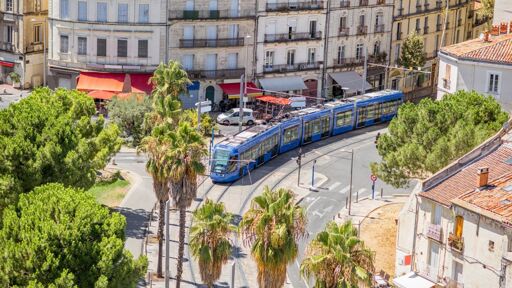Free in Luxemburg for 4 years. Admittedly not all countries have fiscal havens revenues to fund this
https://luxembourg.public.lu/en/living/mobility/public-transport.htmlNo way, people actually use public transport if it’s cheaper than using a car (if you already have one anyway)!?
*surprised Pikachu*
This is only part of the equation, unfortunately - free transit that is of significantly worse in terms of travel time/reliability/accessibility/comfort won’t get used at significantly higher rates.
This is why some transit advocates consider free transit to be an inferior use of funds when compared to investments in the system as a whole, which I think is a fair point.
I’d of course like to see both, as ticketing systems contribute negatively to the overall quality of the system (paying for tickets/passing through ticket gates slows down the system, ticket checkers represent an unpleasant ritual in the system).
ItS Not FreE, YoU StIlL HaVe tO pAy fOR iT sOmeHOw.
Yeah no shit, that’s exactly what taxes are for. Providing services to the masses, not giving handouts to the richest.
I just had a brainwave that I would like to see data on…
It is obvious that use of public transport will soar when it is free, but how much does car use decline at the same time?
If it is enough to significantly reduce road ware, then you can take money from that budget and use to finance public transport.
I wonder however if the reduced car use will also result in lower income from taxes from petrol sales and road tax…
I believe some studies from Tallinn indicated that the primary effect was increased utilization from existing transit riders, unfortunately.
In any case, due to the Fourth power law, practically all road wear is caused by freight vehicles.
Oh yeah, I remember now, there was an early WTYP episode about a bridge collapse where they spoke about road wear.
So once again, rail is the best over land transport mode.
Rail is expensive, though. BRTs are 2-4 times cheaper than light rails.
Rail is a very big upfront investment, but it lasts for longer, all but eliminates the need to actively handle fuel, (you still need a few diesel locos to deal with maintenance) and have an effectively unlimited fuel range.
Buss Rapid Transit (thanks for making me google that btw) is not a bad idea, but since that is basically a trackless tram with way worse capacity and higher pollution, I don’t really see the point other than a temporary lines to determine viabillity of a new tram line.
I know you are about to dig into me regarding the pollution and the range of busses.
So, let me break down my argument.
Pollution, a bus has a much shorter service life than trains and trams, they also have a much lower capacity, this means that you not only need more busses at the start, you also need to replace them much more frequently. This includes hybrids, battery busses, trolly busses and any other kind of bus. So that is using way more resources over time, and causes way more waste over time.
Out of the busses I mentioned above, I want to put special focus on battery busses.
THEY BE HEAVY, MAN!
Battery busses are idiotic, the batteries weigh a shitloaf and it has already caused issues with both roads and busses, where the new busses our local transit authority bought have been banned from driving the route they were supposed be used on due to road and bridge dammage from their weight.
Heavy vehicles cause vastly more dammage to roads and infrastructure than lighter busses.
They also have limited range and need to be recharged at a stop, this also reduces their usefullness, as they are locked in to charge.
“But what about fast charging?”
Sure, that exists and is working, while significantly increasing the wear on the batteries, thus reducing the life time further.
That means we gotta built reproccessing facilities for old batteries to get rebuilt, which means disassembling big batteries with a huge energy potential, and work with toxic substances creating a lot of health risks: https://www.alsym.com/blog/lithium-based-batteries-are-toxic-from-start-to-finish/
This means that reprocessing will either be expensive (reprocessing domestically with oversight) or cheap and unethical (outsourcing to countries with less oversight where labour is cheap and and safety standards are not always followed).
Hybrid busses makes more sense since they have a smaller battery to assist the normal engine, this means that the batteries does not run the entire bus constantly, but they vastly bring down fuel emmisions, and are way less heavy, the batteries lasts longer causing less waste.
Trolly busses is the best bus, light, unlimited range, causes less waste and is over all a fantastic way to implement busses.
What remains is the capacity problem, trains and even trams are way, way more space for passengers, so you need fewer vehicles and last way longer so you don’t need to replace them as often, which is even better.
Hey, excuse me for the late answer, I was a bit busy, and wanted to have more time to read your comment.
Rail has some downsides with respect to maintenance: very few companies manufacter them, so maintenance costs are far higher. The required use of specialized tracks Aldo make these operations more complex, while a BRT can use normal roads if needed.
For me, underground metro systems are the better solution, then BRT then light rail, but this depends a lot on the realities of the cities: geography, budget, political will, etc.
I’m currently reading The BRT planning guide, and have been enjoying it. I think you’ll do as well, as it discusses some nuances of public transport systems in specialized tracks (BRT, light rails and heavy rails) with real life examples, in a very friendly way for non-experts. I used to think metro is the obvious solution, but the book has been really opening my mind of a more complex reality. It has a slight bias in favor of BRTs tho, but the discussion is very interesting anyway.
I’m not the original commentator. Rail has very low maintenance. The electric motors are robust AF and last a long, long time. Steel wheels on steel track have very little wear. Rail is common so maintenance is not exactly specialized. There are plenty of companies that make rail cars when eventual replacement (again a long time) is needed. I have no idea where that very few companies idea comes from.
Buses on the other hand use standard ICE engines which have a lot of maintenance. Engine, transmission, or entire bus replacement is much more frequent. Rubber tire on asphalt, both of those items wear. They can use roads, but if it’s a brt there are dedicated lanes so it takes up pretty much as much room as a train.
Finally you have drivers. A train can be very long with one operator, much lower cost.
I have no idea where the very few companies idea comes from.
Taken from the book I cited in the last comment: A rail system, by contrast, tends to be locked into a permanent dependence on one or two suppliers of rolling stock. While buses tend to use truck engines where the spare parts have over time come to be produced by alternative low cost producers on a massive scale, the manufacturers of rail technology tend to remain monopoly suppliers of their spare parts, as the market for them is far more limited. These monopolistic conditions tend to drive up the operating cost of rail rolling stock. There are only a few major rail manufacturers in the world today (i.e., Alstom, Bombardier, Hitachi, Kawasaki, and Siemens). The scale required to set up local rail manufacturing is unlikely to be achieved in most lower income nations. Instead, manufacturing (and the associated employment) will be based in higher income countries, such as France, Canada, Japan, or Germany. When a city such as Bangkok purchases its rail metro vehicles, the carriages arrive almost fully fabricated (Figure 2.1). This tends to make the vehicles far more expensive.
And it makes sense, as cars are more common than trains. That also seems to increase driver’s salary, as it is easier by volume to find/train a driver for a bus than one for a LRT, given same capacity, and a LRT and BRTs have comparable capacities per vehicle.
These 2 mini-chapters talk further about costs of BRT, LRT and HRT, with several references and data based on real-world operations: Capital Costs and Operating costs




